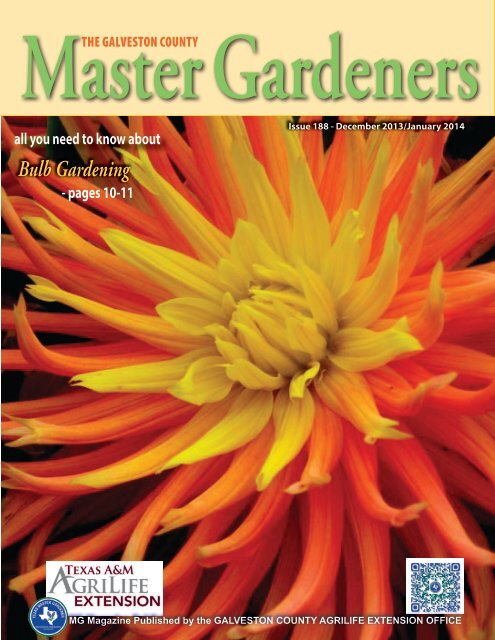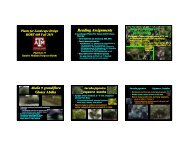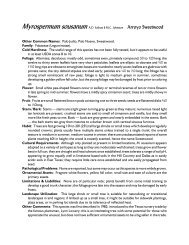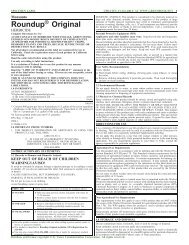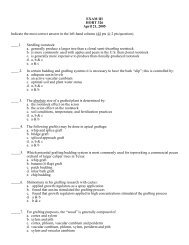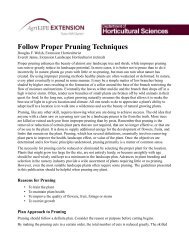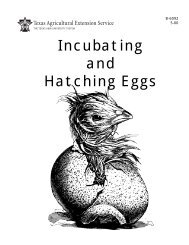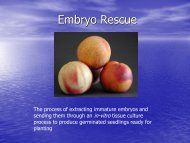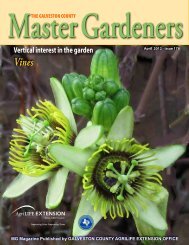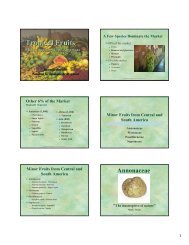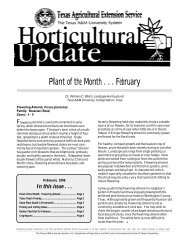Bulb Gardening - Aggie Horticulture - Texas A&M University
Bulb Gardening - Aggie Horticulture - Texas A&M University
Bulb Gardening - Aggie Horticulture - Texas A&M University
Create successful ePaper yourself
Turn your PDF publications into a flip-book with our unique Google optimized e-Paper software.
Master GardenerstHE gALVESTON cOUNTYall you need to know about<strong>Bulb</strong> <strong>Gardening</strong>- pages 10-11Issue 188 - December 2013/January 2014
2013 Master GardenerAssociation LeadershipPresidentJim EdwardsVP for ProgramsChris Anastas, Penny Bessire &Robert MarshallVP for ProjectsJulie Cartmill, Clyde Holt, Bobbie Ivey &Tish ReustleVP for Volunteer DevelopmentPeggy Budny & Laurel StineVP for Media RelationsIra GervaisSecretaryMary Lou Kelso & Cindy CroftTreasurerWes RuzekNewsletter EditorLinda SteberMaster IT SpecialistGregory WerthDemonstration Gardens Team LeadersPeggy Budny; Jackie Auer,Bobbie Ivey, Julie Cartmill, Clyde Holt &Tish ReustleMG Intern Course CommitteePeggy Budny, Bob & Jo McPherson,Yvonne Enos & Lizette GaudinHospitality CoordinatorsJudy Anderson, Lori & Keith Boydston, Dr.Carroll & Marsha Lassiter & Donna WardSpeakers Bureau CoordinatorCindy CroftMG Volunteers Hour RecorderWayne Elliott, Denice Franke &Dr. Margaret CanavanJr. Master Gardener Programs LiaisonBarbara WhiteEarth-Kind Study CoordinatorJohn Jons & Alisa RasmussenPhotography Team LeadersHerman Auer & Tom FountainVideographersBarbara HankinsImage Seekers CoordinatorScott Buckel & Helle BrownState Association DelegatesTerry & Velda CuclisState Association Delegate AlternatesJulie Cartmill & Jim EdwardsGrants & Inkind Support CoordinatorFrank JacksonWebmasterLaura BellmoreAdvisorDr. William M. JohnsonBoard of DirectorsJohn JonsCamille GoodwinDotti KrustchinskyFrank ReschKen StebleinYou might be a Master Gardener—if you argue constantly thatcompost smells sweet, you delay vacation travel until after theharvest, you get at least a dozen catalogs in the mail - and they sendyou into a state not experienced since teenage dating, people share alltheir plant problems with you, trays of seedlings are on top of yourrefrigerator, cuttings are in the refrigerator, you use Latin words inpublic, when you tour a garden you first look for their compostingset up, you won’t let anyone else prune the fruit trees, and you’re in anational park and you have to resist the urge to pull weeds!Photo by M?G Linda SteberBy Camille GoodwinMG 20082013 has been another remarkable year for our GCMGA. The demonstration gardencontinues to expand with more and varied vegetable gardens to support our communityfood banks, building projects continue at a fast pace, a beautiful new Earth-Kindgarden is taking shape in the north end of the garden just before you enter the serene Asiangarden, and we’ve had expanding, phenomenal interest in our monthly public garden tours.Our educational programs have inspired an ever growing number of participants over the2013 calendar year and they continue to be popular both for weekend courses and week-nightofferings. Of course we conducted two successful plant sales this past year and are lookingforward to our next sale in the spring. A special thanks goes out to all the MGs who volunteertheir time and talents to make us successful! Please continue to volunteer; many are needed tocontinue our success in supporting our Galveston County community.The next few months continue to be one of the best times to get out and work in ourgardens. Our last newsletter for 2013 features several educational articles and other ideas tofit with this season. Laurel Stine has provided timely guidance on an insect pest invadingour region, the Asian Cycad Scale. It is impacting our Sago palms (page 5). Learn or refreshyourself on the correct method to trim crepe myrtles on page 4, discover how to improve thequality of your home’s indoor air with plants on page 6 and find out the facts on that irksomebur clover weed (page 13). This is the time of year to plant bulbs. Many types of bulbs growmagnificently in our Gulf Coast area and some are featured in this month’s “Best Shots” onpages 10-11. Jan Brick’s story on page 9 talks about the much coveted Amaryllis, a type ofbulb. What would the holidays be without a Christmas tree for those who celebrate with one?Dr. William Welch offers alternatives to throw-away trees that will last in your landscape longafter the holidays have passed (page 7). Donna Ward’s piece on page 8 provides a list of activitiesthat will keep us busy until spring and our landscapes beautiful. Enjoy visiting Anne Coppenhaver’sAmazing Yard on page 12 to learn that you don’t always need grass! Don’t miss ourregular features including the Carbide Park update on page 16, and updated coming events,our calendar and the bulletin board.The newsletter team hopes 2013 was a good year for you and your family and wishes all agreat holiday season and Happy 2014!Photo by MG Lola Thomas
How to Reach UsInside This Issue...2 Intro by Camille Goodwin3 How to Reach Us4 Ask a Master Gardener Q&A: Crape Myrtle Pruning by Kaye Corey5 Ask a Master Gardener Q&A: Asian Cycad Scale by Laurel Stine6 Meet Chris Wiesinger—Indoor Plants that Clean the Air by Pat Forke7 Live Christmas Trees by Dr. William C. Welch8 Trowels and Tribulations by Donna Ward9 The Island Garden—Merry Christmas Amaryllis by Jan Brick10 MG Best Shots & Narrative - <strong>Bulb</strong> <strong>Gardening</strong> by Camille Goodwin12 Landscaping Without Grass by Cheryl Armstrong13 Weed of the Month: Bur Clover by Marian Kimbrough14 What's the Biggest Problem with Growing Roses by John Jons15 Seasonal Bites - Roasted Vegetables by Linda SteberTEXAS A&M AGRILIFE EXTENSION SERVICE<strong>Texas</strong> A&M SystemExtension Office:Phone. . . . 281-534-3413, ext. 1-2E-Mail. . . . . . . . .galv3@wt.netTo Submit Newsletter Articles:Contact Linda SteberPhone . . . . . . .281-534-6695E-Mail . . .steber8@msn.comWe encourage your articles!Due the 20th of each month.To Send Volunteer Hours:E-Mail. . . . . .mghours@wt.netSpeakers Bureau:Contact Cindy CroftPhone . . . . . . . . 281-332-9501E-Mailgarden.speakers@gmail.comRTEXAS MASTER GARDENE15 <strong>Gardening</strong> Calendar - December-January by Jenifer Leonpacher & Gregory Werth15 <strong>Gardening</strong> Calendar Video - by Jenifer Leonpacher and Gregory Werth16 Project: Demonstration Gardens by Tom Fountain17 Meeting Minutes - MGA Meeting by Mary Lou Kelso17 The Photography Group - Who We Are by Helle Brown18 Upcoming Events19 Awards - <strong>Texas</strong> MG Conference 201319 Sweet Potato Results from the Test Garden by Ken Steblein20 Bulletin BoardExtension programs serve people of all agesregardless of socioeconomic level, race, color, sex,religion, disability, or national origin. The <strong>Texas</strong>A&M <strong>University</strong> System, U.S. Department ofAgriculture, and the County CommissionersCourts of <strong>Texas</strong> cooperating.References to trade names are made withthe understanding that no discrimination isintended and no endorsement by <strong>Texas</strong> A&MAgriLife Extension is implied.21 The Last Word by Dr. William M. Johnson22 2013 Monthly MeetingsCheck out pages 10 & 11to learn more about bulbgardeningFront Cover Photo by MG Shan Revakhttps://www.facebook.com/pages/Galveston-County-Master-Gardeners/220088841395231To Subscribe to our Newsletter - just clickon the subscribe button aboveInterested in gardening in Galveston County?To receive a free subscription to the GalvestonCounty Master Gardeners' Magazine, pleaseenter your e-mail address after clicking onthe "Subscribe to our NEWSLETTER" buttonabove. You will automatically receive ane-mail message when each issue is posted.Your e-mail address will not be used forany other purpose other than sendingthe e-newsletter. We will not send anycommercial mail to the address providednor will the newsletter itself contain anyadvertisements . . .we are all about the joy ofgardening. Thanks for your interest!
ask a master gardenerBy Kaye CoreyMG 2002Hot Line Topicscrape myrtle pruningQuestion: What is the proper way to prune acrape myrtle?Photos from the MG DigitalLibraryImproper pruning (above) gives you theresults belowGalveston County’s brightest mantles of summer color are from our crape myrtles. Thesetrees flower through the sweltering heat of our summer months and can give us repeatedsplashes of color if pruned correctly. These trees should be allowed to develop their naturalstyle and beauty without cutting off their tops.When it begins to warm in the spring, the practice of chopping off the tops of crapemyrtles has become very commonplace. Many people believe it is required to promoteflowering. Some prune because the plant is too large for the space provided; others see theirneighbors doing it and feel the need to follow suit. Horticulturists have been known to referto this practice as “Crape Murder.”Homeowners, please ask your landscapers not to prune your crape myrtles. City parkofficials, please consider leaving the crape myrtles in your medians and public areas naturalwithout severe pruning. You will see the difference in the performance of the trees. Watchthem fill out naturally and cover with blooms.View the beautiful full crape myrtles in the medians on Clear Lake Blvd in the City ofClear Lake. Those crape myrtles are allowed to grow naturally with a minimum of pruning(only damaged, dead or low-hanging branches as well as suckers). There color display isimpressive and is well-appreciated by motorists travelling the boulevard.Once a crape myrtle has bloomed and shed its flowers, the tree will set seed. If the small,round seed pods weigh the limbs down, use a sharp pair of clippers or hedge trimmers, tocut off the seed pods. New shoots with buds will quickly appear and you will get a secondbloom. The seed pods can be mistaken for flower buds but the pods are larger and harderthan the buds.If the temperatures stay warm into the fall and you continue to remove spent flowers, youmay get a third and fourth bloom from the tree. If you choose to not remove the seed pods,they will fall off and the tree will put out new shoots and continue to bloom anyway.If your trees get untidy, simple grooming techniques can be applied. Suckers or shootsfrom the base of the tree can be removed at any time. Cut them off as close to the soil levelas possible. If you do not remove a limb by cutting close to the trunk, you will get severalshoots in its place. Cut them off close to the tree trunk. The trunks are beautiful during thewinter months. Dead limbs can be removed at any time.Crape myrtles today are available in a variety of sizes (from miniatures to tall trees) andcolors (ranging from white to watermelon red). Many crape myrtle cultivars have diseaseresistance to powdery mildew, the most common disease problem on crape myrtles grownin our area.Select the right tree for your sunny location. Or, you might consider replacing oldertrees with one of the newer varieties. One of the newest and most striking crape myrtles isthe “Black Diamond.” A revolutionary new crape myrtle with stunning, near-black foliagecrowned with masses of vivid red blooms. The mature size is 10’ by 8’ wide.Have you witnessed the trunks of crape myrtles that appear to be twisted or braided? Youcan accomplish that sculptural enhancement by allowing crape myrtle shoots to grow inheight, then simply braid or twist three or four shoots together while they are young.More details on pruning, a video and variety information can be found athttp://aggie-horticulture.tamu.edu/archives/parsons/publications/stopthecrape.htmlThe trees above were allowed to grownaturally with minimal pruningThe Galveston County Master Gardeners Magazine - December 2013/January 2014 - Page 4
. . . Q&AAsian Cycad Scalea formidable insect pest of cycadsQuestion: I see strange white stuffon my sago palm?By Lasurel StineMG 2002Our beloved Sago Palm (Cycad revoluta)has been under siege recently. How manyof us have watched these formerly easy-carespecimens turn white, then yellow, thenwither and die? The MG Hotline oftenreceive calls from county residents about“…’white’ stuff appearing on sago palms.”Worse, many of these specimens have belongedto us, the Master Gardeners!Sago Palms as well as other members ofthe family Cycadaceae are susceptible toa relatively new pest known as the AsianCycad Scale. Members of Zamiaceae andStangeriaceae (two plant families that areclosely related to the family Cycadaceae) arealso susceptible to this insect pest, althoughnone are as widely grown here as the SagoPalm.Asian Cycad Scale (Aulacaspis yasumatsuiTakagi) is an armored scale which was firstdiscovered in Miami, Florida in 1996. Itoriginated in Thailand and Southern China,and is believed to have been imported inlegal shipments of Sago Palms.This scale is difficult to control becauseit infects the roots at depths of up to 2 feetand it spreads easily from adjacent properties.Release of beneficial predators has notbeen successful in controlling scale populations.Damage first shows up as yellowish spotson the upper leaf surfaces, but fronds laterbecome brown and shriveled. Badly infestedsago palms can be completely covered witha white crust composed of several layers oflive and dead scale insects.This insect pest multiplies quickly andthe crawler stage can be easily disseminatedby air currents. A medium-size sago palmleft untreated may be killed within a year.If the pups (small plants around base oftrunk) are coming up white, there is aheavy infestation below ground.A number of years have passed since thispest has come to live among us, and wehave been able to better determine whichmethods Photo by provide MG Margie better control. JenkeThe “gardener’s shadow” is of utmostimportance in the management of theseinsects. Vigilance is paramount, and a sprayprogram must be commenced as soon asscale insects are detected. Scout the plants,inspecting the trunks and the lower leafsurface especially in the spring when thenew crawlers hatch out.To control, try washing the plant witha hard stream of water to knock off someof the scale insects. Apply a foliar spray ofa horticultural oil product like Ultra-Fine®oil, SUNSPRAY® oil, neem oil or anothersimilar product.Malathion and other broad-spectrumpesticides can be used, but they will alsokill the beneficial insects that feed on thesepests. Complete coverage is critical to goodcontrol; use a fine high-pressure sprayer tocoat the entire plant including the undersideof leaves and every tiny crevice. Alsospray the soil or the mulch under the plantleaves. Repeat these sprays once a week foran entire month. If you don’t apply multipleapplications, the insects will very likelyreturn.Following treatment, continue to checkplants in case the insects are coming backfrom the roots or from neighbors’ plants.Because they are spread by the wind, it isimportant for an entire neighborhood toPhotos: B. Castro, <strong>Texas</strong> AgriLife Extension Servicetreat infested plants within the same timeframe.If there are heavy infestations on theleaves, remove heavily infested fronds(leaves) before treating and bury them onyour property or place them in plastic bagsfor disposal by household trash pick-up(do place with yard trash or green recyclingmaterial). A root drench of 2 percent horticulturaloil may be helpful in controllingpopulations of the insect pest below ground,but it will be difficult to achieve adequatecoverage. Safari is a systemic product that iseffective and can be applied by commercialpest control companies.Photo by MG Linda SteberThe Galveston County Master Gardeners Magazine - December 2013/January 2014 - Page 5
By Pat ForkeMG 2010how many plants do you need?<strong>Gardening</strong> Indoors with Plants thatClean the AirTo see how to plant in a container, watch this video: http://www.youtube.com/watch?v=cx_TGnAOKcYAnd, don’t forget to fertilize your indoor plants periodically.With more people spending more time indoors, TheWorld Health Organization (WHO) has stated “thereis probably more damage to human health from indoorpollution than from outdoor pollution.” With the advent of theenergy crisis, newly constructed building are better insulated andsealed tightly to conserve heat and reduce air conditioning costs.While this does save money and energy, more pollutants aretrapped indoors and have less opportunity to dissipate to theoutside. Also newly constructed building are more likely to beconstructed with man-made building materials and furnished withsynthetic carpeting, fabrics, laminated counters, plastic-coatedwallpaper, and other materials known to “off-gas” pollutants intothe interior environment.There is the phrase “sick-building syndrome” used to describethis result. If your home or office is older and leaky and drafty, youmay not need to worry about as many interior pollutants. However,if you live or work in a newer, energy-efficient building where theair feels stale and the circulation is limited, you may exhibit thesymptoms associated with indoor pollution. These include allergies;asthma; eye, nose, and throat irritations; fatigue; headache;and nervous system disorders in addition to respiratory and sinuscongestion.In the late 1980’s the National Aeronautics and Space Administration(NASA) and the Associated Landscape Contractors ofAmerica studied various plants with the intention of finding waysto purify the air for extended stays in orbiting space stations. Therewere nineteen different plant species studied over two years.Most of the plants are true houseplants which can be keptindoors year-round. These indoor plants evolved in tropical or subtropicalforests where they received filtered light. Because of this,these plants are able to photosynthesize more efficiently under lowlight conditions thus allowing them to process gases in the indoorair efficiently.Benzene, Trichloroethylene and Formaldehyde are the threechemicals tested with the indoor plants. Benzene is a commonsolvent found in oils and paints. Trichloroethylene is used in paints,adhesives, inks and varnishes. Formaldehyde is used in many buildingmaterials including particle board and foam insulations. WhileNASA found that some of the plants were better than others forabsorbing these common pollutants, all of the plants had propertiesthat were useful in improving overall indoor air quality.The plants best suited for treating air contaminated with Benzeneare English Ivy (Hedera helix), Gerbera Daisy (Gerbera jamesonii),Florist’s Mum (Chrysanthemum x morifolium), Peace Lily (Spathiphyllum‘Mauna Loa’), Bamboo or Reed Palm (Chamaedorea sefritzii),and Snake Plant (Sansevieria trifasciata).For treating trichloroethylene, you might choose the Peace Lily,Gerbera Daisy, and Bamboo or Reed Palm. The Bamboo or ReedPalm, Snake Plant, Warneck Dracaena (Dracaena deremensis ‘Warneckii’),Peace Lily, Red-edged Dracaena (Dracaena marginata),Golden Pothos (Epipiremnum aureum), and Spider Plant (Chlorophytumcomosum) worked well for filtering formaldehyde. See the boxon this page for a listing of all fifteen plants recommended from thisstudy. The top five indoor plants recommended by TreeHugger.comare the Bamboo or Reed Palm, Gerbera Daisy, English Ivy, Florist’sMum, and Peace Lily.Soil and roots were also found to play an important role in removingair-borne pollutants. Microorganisms in the soil will becomemore adept at using trace amounts of air-borne pollutants as a foodsource as they are exposed to them over an extended period of time.This process become more effective if lower leaves that cover the soilsurface are removed so is as much soil contact with the air as possible.How many plants do you need to significantly improve the airquality in your home? The NASA study recommends you use 15 to18 “good-sized” houseplants in 6 to 8-inch containers for a 2,000square foot home. The more vigorous the plants, the better job theywill do at removing pollutants.For a more aggressive approach to “growing” your own indoorair, check out this video by Kamal Meattle about a 2009 study donein India: http://www.treehugger.com/green-food/ted-talk-growyour-own-fresh-air-with-plants.html.Meattle lists three plants thatare used in India with significant results. Those plants include theAreca Palm (Chrsysalidocarpus lutescens). Other plants include moneyplant or Golden Pothos in addition to Snake Plant (also known asthe mother-in-law’s tongue) which comes highly recommended foruse in bedrooms as it converts carbon dioxide to oxygen at night atrelatively high rates.While some plants may be better than others at improving airquality, all plants absorb carbon dioxide and add oxygen, humidityand beauty to our surroundings. Indoor gardening can be doneyear-round, in all types of weather, and without the threat of waterrationing, weeds, or mosquitoes.Best air-filtering houseplants(Reported in a NASA Study)English Ivy Hedera helixSpider Plant Chlorophytum comosumGolden Pothos Epipiremnum aureumPeace Lily Spathiphyllum ‘Mauna Loa’Chinese Evergreen Aglaonema modestumBamboo or Reed Palm Chamaedorea sefritziiSnake Plant or Mother-in-law’s tongue Sansevieria trifasciataHeartleaf Philodendrom Philodendron scandensSelloum Philodendron Philodendron selloumElephant Ear Philodendron Philodendron domesticumRed-edged Dracaena Dracaena marginataCornstalk Dracaena Dracaena fragransJanet Craig Dracaena Dracaena deremensisWarneck Dracaena Dracaena deremensis ‘Warneckii’Photo Weeping by MG Fig Ficus Herman benjamina AuerThe Galveston County Master Gardeners Magazine - December 2013/January 2014 - Page 6
later to become a permanent part of your landscapeLive Christmas TreesThe boughs of holly have been used to deck the halls, andsprigs of mistletoe hang over every door, but the one plantthat Christmas would not be complete without has yet to bebrought in—the Christmas tree. The kids are anxious; they want todecorate the tree NOW! But this year, for something new and longerlasting,a living tree was what you wanted. Now what?The first thing to do is pick out a tree. Consider the following:Aleppo Pine, Japanese Black Pine, Japanese Yew, Loblolly Pine, DeodarCedar, Juniper, or other coniferous evergreens. Perhaps you prefera broad-leafed tree; possibilities include: American Holly, BurfordHolly, Compact Cherry Laurel, or Yaupon. Or you might decideon a tubbed plant to remain inside after the Christmas season? TheNorfolk Island Pine, kumquats, calamondins, or Yews would be goodchoices.Once the tree is chosen (if it isn’t tubbed), a container must bechosen as well. If the tree roots are balled and burlapped, a containermust be used that will allow at least an inch of peat moss, pottingsoil, or compost around the ball to prevent drying out. If the planthas been grown in a container, it can be made much more attractiveby placing it in a redwood tub, ceramic or clay pot, or even a woodenbox lined with a polyethylene film liner. All containers should be welldrained to prevent damage to the roots caused by excess moisture. Apan underneath the container will also prevent floor damage.Now that the tree is in the container and in the house, you canstart to give the kids a little leeway. All you have to do now is find agood place for the tree that is not in the stream of heat or near a stoveor radiator. When not occupied, the room should be kept as cool aspossible, and the plant should be watered when dry. A simple wayto tell when the plant needs water is to push a sharpened pencil intothe soil. If the pencil comes out dry and clean, the plant needs water;otherwise, wait until the next day.After Christmas, it is best to plant the tree in the landscape assoon as possible. The selected site for the tree should fit into thelandscape design, and allow sufficient room for growth and development.The pit dug for the tree should be large enough to allow threeto four inches of soil along the vertical sides of the soil ball. It shouldbe planted at the same depth it was planted at the nursery or in thecontainer. For the backfill, add one part peat moss, pine bark, orcompost to two parts soil, and pack this mixture firmly around theball. When the pit is three-fourths full, the tree should be wateredthoroughly, and then filled the rest of the way. If the plant was balledand burlapped, the burlap should be loosened before completely fillingthe hole.The tree can be used to serve another purpose—the beautificationof your yard. Planted into your landscape, these trees can add anice touch in the spring, summer, and fall, and can even serve as anoutdoor Christmas tree next time Christmas rolls around.The tree is now a permanent part of your landscape. To keep ithealthy while it is adapting to its new environment, here are sometips:• Water it regularly, but allow the soil to dry a littlebetween waterings.• Mulch the surface with some kind of organic matter,to reduce weeds and conserve moisture.• Avoid fertilization until June or July followingplanting.• Keep weeds and grass down, to preventcompetition.Photo by MG Mona RayBy Dr. William C. Welch, Professorand Landscape Horticulturist (Retired)<strong>Texas</strong> A&M AgriLife Extension Service, College StationIn 1991, MG Mona Ray's Live Christmas Tree (Norfolk Island Pine)in Dickinson started out in a pot and was then planted in her yard.Just look at it today!The Galveston County Master Gardeners Magazine - December 2013/January 2014 - Page 7
By Donna J. WardMG 1996you think your gardening chores overTROWELS & TRIBULATIONS in a Suburban Garden(Editor’s Note: This is a reprint of Donna’s article for La Ventana Del Lago,the City of El Lago’s neighborhood newspaper.)Wow – That was quick! One morning in November wewere still enduring what seemed to be an endless summer,and by that afternoon winter had arrived. By the nextmorning, most of us were looking for those warm fuzzy slippers thathad been shoved to the back of the closet.Now you may think that your gardening chores are over whenjingle bell season arrives, but you’d be wrong. I know, those lastminute gifts need to be purchased, and we couldn’t be further behindin the cookie baking department, but December is your last chanceto complete the gardening chores you neglected last month. Are webehind – or what?I know it’s hard to believe, but spring isn’t that far off, and thereare many chores we need to complete in preparation for that season.That large dead oak tree you had removed this summer was shadingthose azaleas, and now they’re getting too much sun. There couldn’tbe a better time to move them. Just be sure to keep them mulchedand watered to prevent any winter damage. Same goes for the camellias.Maybe you don’t have any to move, but it’s also an ideal time toplant new ones. Azaleas and camellias thrive in an acid soil. Acidifiersare available in both granular and water soluble form.If your favorite nursery still has pots of pansies it’s not too lateto add winter color to your landscape. While you’re at the nursery,take a look at the snapdragons. A stand of tall yellow snaps behinda grouping of purple pansies is a real attention-grabber! Rememberthat if you keep the old faded pansy blooms removed, the more theywill reward you with new happy faces. You can also get some instantcolor with ornamental kale, primroses and cyclamens.If you like the challenge of planting seeds, nasturtium, Californiapoppy and phlox can be put in a prepared bed right now.Chances are there’s a rack of vegetable seed packets next to theflower seeds at the nursery. You could start some onion seeds indoorsnow and grow your own transplants for planting in the vegetablegarden in January or February. Always use a sterilized potting soilfor this as soil dug from the garden contains fungal organisms and agazillion weed seeds. Try to pull weed sprouts from a pot of hair-likeonion sprouts – Good Luck!If the weather guru on your preferred television station predicts afreeze, unwind the hose and give everything a good watering. Moreplants die over winter from lack of water than from the cold. Justbecause it’s winter, don’t put the hose in the garage. If a freeze ispredicted and you put a protective cover over your plants, be sure toremove it ASAP in the morning. Never, never put plastic sheetingdirectly on a plant. Plastic touching the leaves will turn them brownby morning. Always put it on top of the protective cover.If someone gives you a potted amaryllis for the holidays, consideryourself special. These long lasting beauties make a great gift forall the special people on your list, too. Remember to tell them thatwhen the blooms fade, it can be put directly into a well-drained spotin the garden and then forgotten. Don’t plant it too deep; be surethe neck of the bulb is above ground. It will tolerate full sun, butprefers a little afternoon shade. I almost forget that I have mine, andthen suddenly a huge red blossom appears amongst the green of thegarden - Lovely, to say the least.Before the long awaited gift-giving day arrives, cut branches ofgreenery to decorate the house. Yew, ligustrum, holly, magnolia,juniper, and pittosporum branches can be turned into attractiveholiday decorations. A light pruning won’t hurt the shrubbery, and itmight even benefit them.Take the bag of tulip and hyacinth bulbs out of the refrigeratorwhere they have been tricked into thinking it’s winter for the past 6or 8 weeks. Let someone else clean up the Christmas dinner leftoversand wash the dishes while you go outside and plant bulbs. If bychance you’re too stuffed to bend over - you could wait until NewYear’s Day.Happy Humbug.Photo by MG Linda SteberThe Galveston County Master Gardeners Magazine - December 2013/January 2014 - Page 8
THE ISLAND GARDENMerry Christmas Amaryllis(Editor's Note: This is a reprint from Jan's article in "The Islander" magazine.)By Jan BrickMG 2001Since most of my ten grandchildren have grown up, it seemslike eons ago that I would make a special trip to my favoritegarden center to purchase Amaryllis bulbs for them—redfor the boys and pink for the girls! This was the time of the yearfor our special moments working together to “force” the bulbs intobloom before the holidays were upon us. <strong>Bulb</strong> kits are available forpurchase now and are the easiest way to teach children a gardentask that is quickly accomplished—with gratifying results in a shortspan of time. These kits contain a bulb, a planter, and the soil thatyou need. Just follow the directions—a child can do it—which isthe point, of course! Within days of planting, the stem can be seensprouting from the bulb and growing visibly day after day withbeautiful blooms soon after as the prize. Once the plant has beenspent, it can be planted outside in a flower bed where year after yearit will reappear reminding us of our special moment and providingus yet another reward with no effort on our part.These special moments are a part of what I call my “Reap WhatYou Sow” effort. In these days of extended families, children mayhave multiple sets of grandparents. This affords us an opportunityto create little vignettes of memories by sharing our own particularinterests and talents with our young progeny. Within our blendedand extended family, I am known as the gardening grandmother.“Gee” is the grandparent name that I have come to be called. Ialways had a supply of child-size gloves, garden implements andgarden books that were written with youngsters in mind. WhileI attempted to foster an interest in gardening in the hearts of mygrandchildren, I also experienced additional pleasures myself fromthe innocent questions and comments of an inquiring child. Whena child adopts a curiosity for your particular interest, you are rewarded!You do indeed “Reap What You Sow.”Amaryllis is a small genus of flowering bulbs with two species. Formany years there was confusion among botanists over the generaAmaryllis and Hippeastrum. Species in both genera are similar inappearance except that Amaryllis belladonna has a solid flower stemwhile plants in the genus Hippeastrum (including Amaryllis) has ahollow flower stem.Plants known commonly as “Amaryllis,” “Dutch Amaryllis,”or “Giant Amaryllis” belong to the genus Hippeastrum, and thosegrown today are mostly hybrids of several species from South Americaand South Africa. Most of the so-called Amaryllis bulbs sold as“ready to bloom for the holidays” actually belong to genus Hippeastrumdespite being labeled as ‘Amaryllis’ by sellers and nurseries.The name Amaryllis is taken from the name of a shepherdess inVirgil’s pastoral Eclogues, from the Greek (amarysso), meaning “tosparkle.” The species was introduced into cultivation from SouthAmerica’s tropical regions at the beginning of the eighteenth century.Reproducing slowly by bulb division or seeds, amaryllises have graduallynaturalized in many areas.Of all flowering bulbs, Amaryllis is the easiest to bring to bloom,indoors or out and over an extended period of time. These facts plusthe beauty of the extremely large flowers make Amaryllis popularamong novice and experienced gardeners alike and in demand worldwide.The flower heads are often so large the stems cannot supportthem. It may be helpful to insert a thin stick inside the hollow stemfor support.Amaryllis can be found in a spectrum of colors and color combinationsincluding various shades of red, white, pink, salmon andorange. There are striped and multicolored varieties as well, usuallycombining shades of pink or red with white.The fleshy stalk of an Amaryllis retains a great deal of moisturegiving the flowers a water supply within the plant itself. You can useAmaryllis as a dry decoration for a limited period; a few stems withfully blown flowers can be placed on a dinner table without becominginstantly limp.Topped by four or five substantial sized blooms, these flamboyantstarry trumpets (which spring from huge papery bulbs) make animpressive display. The ability to survive and sustain itself is anotherattractive detail of this plant; an Amaryllis bulb may produce bloomsfor up to seventy-five years! The Amaryllis bulbs in my gardens weretorn from the soil during Hurricane Ike and lay strewn around theyard—I cleaned them up—replanted them and they have continuedto bloom every year since!Definitely fitting nicely into my “user-friendly” category of favoriteplants, the Amaryllis will make an excellent addition to your flowerbeds and containers. Try some…you will be glad you did!Planting Period: October until the end of April.Flowering Period: Late December until the end of June.Flowering time is 7-10 weeks.Larger bulbs produce more flowers.Always store unplanted bulbs in a cool place between40-50 deg. F. Photo by MG Deborah RepaszThe Galveston County Master Gardeners Magazine - December 2013/January 2014 - Page 9
MG BEST SHOTSCrinum 'Ellen Bosanquet' by Anna WygrysGladiolus by Margie JenkeCanna by Sam PowersWater Lily by Eileen StoreyDahlia by Shan RevakNarcissus tazetta 'Paperwhite' by Linda SteberThe Galveston County Master Gardeners Magazine - December 2013/January 2014 - Page 10
…and Narrativebulb gardening<strong>Bulb</strong>s are a group of plants known as geophytes. Geophytes areplants with underground storage organs that contain food andenergy for the plant’s life cycle. Geophytes go through a cycleof putting out leaves, blooming, dying back to the ground, and goingdormant until the next growing season.<strong>Bulb</strong>s generally fall into two groups: spring-flowering which areplanted in the fall and summer-flowering which are planted in thespring. Spring-flowering bulbs are hardy bulbs and are planted priorto the first freeze. Many, like some daffodils, naturalize and are leftin the ground to spread and re-bloom each year. Summer-floweringbulbs are tender bulbs need to be dug up and stored between seasons.There are five classifications of geophytes. Understanding thedifferent structures is important because they affect how the bulb isplanted, how it grows, and how it reproduces. Classifications are:TRUE BULBS are rounded, with a flat bottom (called a “basalplate”) that produces roots, and a top that produces the stem. Theygrow vertically and must be planted right-side up. <strong>Bulb</strong>s have layers(like onions), and if you slice a true bulb right down the middle,you’ll find an embryonic bud at the center of the bulb, surrounded bylayers of food. True bulbs reproduce by creating smaller bulbs (called“offsets” or “bulblets”) attached to the parent bulb. These can be separatedand planted to produce more plants. Examples include Tulip,Lily, Narcissus, Hyacinth, Daffodil, Crinum and Amaryllis.CORMS look similar to bulbs on the exterior but they are actuallythe fattened base of the stem itself. A corm doesn’t grow in layers orhave an embryonic bud at the center – it’s purely a solid-texturedfood supply for the stem above. As the plant grows and blooms, itutilizes the food in the corm, and the corm shrivels and dies. Meanwhile,it has produced new, baby corms (called “cormels”) next toit, which sprout next year and can be transplanted to propagate theplant. Examples include Crocus and Gladiolus.RHIZOMES are actually fat underground stems that grow horizontally.They creep along just under the soil surface and sprout stemsand leaves upward, and roots downward, all their length. Unlikebulbs and corms, which are more like self-contained units, rhizomeshave many growing points and can be propagated by cutting theminto sections. Examples include Calla Lily, Canna and Bearded Iris.TUBER is sometimes used as a catch-all for any plants that don’tfit into the other categories listed above. True tubers are swollen undergroundstems that have eyes (like potatoes) where plants and rootswill sprout. They don’t have a basal plate – instead, roots grow allalong the bottom and sides, with plant growing points along the topsurface. They also may be propagated by cutting them into pieces.Examples include Caladium and Water Lily.By Camille GoodwinMG 2008TUBEROUS ROOTS look very similar to tubers but are actuallyswollen roots, not stems. They don’t have eyes. Tuberous roots oftensprout at one end (called the “crown”) and grow in clumps, so alarge flowering plant may have multiple tuberous roots radiating outfrom a sprouting “crown.” The plant sprouts from the base of theold stem, not from the root. Propagating tuberous roots is trickier,because many of them will only sprout if the divided section containsadequate crown tissue. Examples include Dahlia, TuberousBegonia and Anemone.Successful bulb gardening in our low chill hour region requirescareful selection of bulbs. Some need weeks of chilling in yourrefrigerator before you can plant them in the ground. Always besure that the bulbs you purchase are appropriate for our climate.Most bulbs are reported to bloom best in sunny locations in soilthat is slightly acid to neutral (pH 6-7), porous, crumbly and welldraining.While most soils in the Galveston County growing regionare slightly alkaline (between pH 7 to pH 8), a wide variety of bulbsgrow very well here.Most purchased bulbs will come with its specific instructions asto how to chill (if needed), depth to plant, type of fertilizer needed,color, size, spacing, etc. If someone trades you a bulb, it’s easy toresearch to find its growing requirements. Most bulbs will last a longtime, so it’s worth the effort to purchase good quality bulbs.Prefer to force bulbs instead of planting outside? Forcing makesbulbs flower out of season. Most spring bulbs can be forced. Popularbulbs to force include daffodils, amaryllis, paperwhites, hyacinth,tulips and crocus. For successful forcing, choose bulbs that areplump and firm. The larger the flower bulb the bigger the bloom.Prepare them by placing them in a refrigerator (between 35 °F. and45 °F.) for 10-12 weeks. Do not put them in bins with fruit!Once pre-chilled, you can force in soil or in water. For soil, fillthe pot with a light potting mix. Don’t use soil from your garden.Plant the flower bulbs you will be forcing halfway to three quartersof the way deep into the pot. The pointy tops of the bulbs should beout of the soil. Water the bulbs and keep the soil moist.For water forcing, you can also use a pan or bowl filled withpebbles. Bury the bulbs halfway into the pebbles, with the pointsfacing up. Fill container with water so that the lower quarter of theflower bulb is in the water. Make sure that the container always haswater. Keep your planted bulbs in a cool (50 °F. - 60 °F.) place untilit starts to form leaves. Once leaves appear, you can move the flowerbulbs to a warmer location. They prefer bright, indirect light. Makesure to keep your forced bulbs watered. The roots should alwayshave moisture. Once your forced bulbs have finished blooming, cutthe spent flowers off and plant them outside.The Galveston County Master Gardeners Magazine - December2013/January 2014 - Page 11
landscaping without grassTalented Gardeners, Amazing Yardsby Cheryl ArmstrongMG 2010More and more isbeing written aboutthe use of water ingardens and lawns. There isdiscussion about reclaimingrainwater, minimizing runoff,and Xeriscaping as an alternative.Some cities, like Las Vegas,Nevada, for example, are requiringnew homes to have frontyards with no lawns at all. So,what is a gardener to do?This month we are featuringthe landscape of Dickinson resident,Anne Coppenhaver. Severalyears back, Anne decidedit was time she found a way tocreate a beautiful landscape thatnot only required less water;but also required less maintenance—ahuge undertaking.She and her husband broke thetasks into doable phases. Theymapped out their yard, drew upa plan and went to work morphingtheir back landscape.As you look at the photosof their backyard, you will seethat there is no lawn at all. Thebackyard is entered throughdouble glass doors. As youcome out of those doors, thereis a bed with a tiered fountain,designed as a focal point, todraw you into the garden.Meandering around the yard isa wide gravel path. The gravelpath was constructed with aFrench drain to minimize waterpooling along the path. Largeplant beds encompass the rest ofthe yard with lush tropicals andnatives that are known to growwell in the Houston/Galvestonarea. A desire to hide the fencewas solved by planting BlackBamboo, Phyllostachys nigra, afast growing, non-invasive variety.The end design is to haveno irrigation at all. All plantswill be sustained by naturalrainfall and moisture in the air.Until they reach that point,however, they recognized thatnewly planted plants neededirrigation, so they installed atemporary above-ground irrigationsystem. This system will beremoved when the plants’ rootsystems are mature enough notto need the additional watering.Flowering pots add the seasonalcolors. There are a minimumnumber of pots carefully locatedon the patio. These add beautywhile minimal gardening effortsare required. Statuary andtrellises dotted here and therecreate interest and keep the eyemoving.The front landscape issomething to behold as well.While they kept some lawn inthe front, it is minimal and meanderingin creative paths. Thebulk of the landscape is large,wide beds, sometimes separatedby creative stone pathways andother times lawn. Pine needlesfrom their trees are rakedup and used as mulch withminimum mulch being broughtin from the outside. The viewfrom the street is one of orderand beauty. Who would guess itrequires so little of their time?This yard captured myinterest because it is so easy forme to get caught into a trapof more, more, yummy plantsand flowers until pretty soon Ihave a maintenance nightmareon my hands. The Coppenhavers’inventive landscape hasreminded me that being responsiblewith resources does nottranslate into an ugly yard.The effort to create a sustainablelandscape requiring less ofmy time and less water is worthtaking another look at it. Thankyou, Anne, for sharing yourbeautiful landscape with us.The Galveston County Master Gardeners Magazine - December 2013/January 2014 - Page 12
invasive common cloverWeed of the Month: Bur CloverWhen using herbicides and other pesticides, always read and follow label directions carefully.Acommon clover-typeplant that grows in thisarea and is quite invasiveis known as bur clover. Eventhough it is not a true clover,two species identified in thisarea are commonly known aslarge bur clover (Medicago polymorpha)and small bur clover(Medicago minima). Both speciesare dicots (broadleaf plants)in the legume family and areclosely related to the true clovers.Large bur clover and smallbur clover are native to Europebut brought to the States asgrazing material (fodder crop)for cattle.Large bur clover can growfrom 6—22 inches and hasflower clusters consisting of3—5 flowers, blooming in earlyspring. Small bur clover cangrow from 6—18 inches longwith 10 or more flowers displayedper head (inflorescence).In this region, bur clover’sblooming period is from Februaryto June but can grow yearround. Germination is in thefall season when temperaturesare cooler.Bur clover can be readilyidentified by its small pea-likeyellow flower, three greenclover-shaped leaves and purplestems. It reproduces from seedscontained in “burred” seedpods,as well as spreading prostatestolons, which allow it totolerate close mowing, increasingits survival and spreadingabilities. The exterior of burredseedpods have numerous velcrolikehooks that may becomeentangled in animal coats orhuman clothing, which serves asa common means of dispersal.Preventive practices, such asgood turf management, are bestin reducing infestation. Herein the Gulf Coast area, a lawnfertilization program based onsoil tests will encourage growthof a dense, healthy turf, whichwill inhibit the clover from becomingestablished. Mechanicalor physical removal is notrecommended because stolonsmay break and sprout, increasingrather than decreasing theinfestation.Pre-emergent herbicides likethose contained in “weed andfeed fertilizers” may be used toprevent seed germination inthe fall. Timing of the applicationis critical for effective control.Early October is recommendedas cool fronts typicallyoccur during this time and theseeds of cool season weeds startto germinate. While weed andfeed fertilizers for lawns can bean effective tool, they can stressor kill landscape trees andshrubs if applied under or neartheir drip line.Over-the-top herbicides orpost-emergence herbicides like“broad-leaf weed killers” maybe used in the spring. If youchoose to use a post-emergenceherbicide, do so when the burclover is actively growing. Applya broadleaf lawn herbicidecontaining a combination of2,4-D and MCPP or triclopyras its active ingredients lateMay or early June. More thanone application may be necessary.To be most effective, theherbicide should be appliedwhen temperatures are between60—80 degrees, no rainis forecast for 24—48 hours,and no wind is present to blowthe herbicide onto desirablebroadleaf plants.For spot treatment of small,unwanted patches, you canavoid the use of a tank sprayerby mixing the herbicide accordingto label directions andthen applying it with a disposablepaint brush or a spongetied to a stick. Glyphosate(Roundup) works well for thissince the area may be reseededseven days after application. Beaware, though, that glyphosateis non-selective—it can kill ordamage the grass or other green,living plants that it touches.Be sure to read and follow theproduct’s label instructions andprecautions.ScientificNameMedicago polymorphaMedicago minimaCommonNamesLarge Bur CloverSmall Bur CloveBy Marian KimbroughMG 2007Bur clover can be readily identified by its small pea-like yellowflower, three green clover-shaped leaves and purple stems.Photos by GCMG Digital LibraryThe exterior of burred seedpods have numerous velcro-like hooksthat may become entangled in animal coats or human clothingwhich aides its dispersal.The Galveston County Master Gardeners Magazine - December 2013/January 2014 - Page 13
often asked questionWhat's the biggest problem withgrowing roses?By John JonsMG 2003Ioften get asked the question “What is the biggest problem withgrowing roses?” and my answer tends to surprise a lot of people.For me the biggest problem in growing roses is “weeding!” Iwould anticipate that most people would expect the answer to beone of the following: selecting the right rose; preventative sprayingfor fungus or insects; watering; fertilizing… Weekly, I spend more(non-enjoyable yard work) time weeding my rose beds than doingany other garden activity.As a rose gardener, you build the rose beds and plant the rosesand then the weeds come. I’ve read the literature on weed prevention/control,attended the seminars on weed prevention/control andconsulted with other Consulting Rosarians and Master Gardeners onweed prevention/control, and I have come to the conclusion there isminimal prevention and its mostly the control of the weeds.I have tried industrial strength weed blocking cloth, and the weedsgrow on it and use it to anchor their roots to fight you when you tryto pull them out of the ground. Then lots of weeds grow back betterand stronger from their roots that were stuck in the weed cloth. Itried mulch 3 to 6 inches deep, and I have discovered that someweeds love to grow in and on mulch. Plus, when you put fertilizerintended for the roses on the mulch and you add a sprinkler system,you grow more and more healthy weeds. I have even discoveredthat weeds seemed to like native mulches better. I briefly tried usinga small burner to toast the weeds, but that set the mulch on fire. Itried herbicides. One kind is supposed to go to the plant’s root andkill it, and another kills the weed on contact; so while spraying theweeds with the herbicides, I managed to kill a rose and create a yellowfringe on the leaves of some roses. I discovered that some weedsseem to be impervious to the herbicides available to the homeowner.The weeds appear to be winning.While trying all the different weed preventing and/or controltechniques, you learn that the weeds you fight all winter long andalmost beat are replaced by different and more aggressive summerweeds. You also find that some weeds have billions of seeds perplant. Some weeds have innumerable ways of self-propagation. Plus,some of the annuals and perennials you purchased at garden sales,that the vendors claim are great for this area, turn up in your rosebeds as prolific weeds. I have also discovered that, if you are notcareful, plant swaps can turn out to be weed swaps.I think I have learned a lesson that has been blatantly obvious tome but I seemed to have missed it. When I began to learn aboutroses, I studied books that featured the great rose gardens of Europe.On several visits to Europe I noticed that there were not many ofthe great rose gardens left. Where great gardens once existed thereare now very large lawns. It appears that the owners of these greatgardens could no longer afford to pay people to weed, so theyreplaced the gardens with lawns. The weeds won!For the last 15 years my rose beds have gotten larger and my lawnhas gotten smaller but my garden maintenance, specifically weeding,appears to have significantly and disproportionally increased. Dueto this painful increase in yard work, my lawn area may soon startgrowing again. I'm thinking that in my garden, the weeds may bewinning.John’s back garden rose bed.The Galveston County Master Gardeners Magazine - December 2013/January 2014 - Page 14
irresistible side dishSeasonal BitesHere is a recipe with a different twist using fresh vegetablesRoasted Vegetablesby Linda SteberMG 1991You can use any combination of fresh vegetables, but I used zucchini, yellowsquash. red potatoes and onions..Preheat oven to 400º. Cut the vegetables in "bite-size" pieces and put in anuncovered 9x13" casserole dish. Season with salt and pepper and drizzle with oliveoil. Bake for 45 minutes. Stir once in the middle of baking.Combine 1 cup French fried onions, crushed and 1/2 cup panko (Japanesebreadcrumbs). Remove casserole from oven and sprinkle with breadcrumbmixture. Seed and dice 2 plum tomatoes and sprinkle over vegetable mixture.Return to oven for 10 minutes. Serve immediately.December/January "Things To Do"<strong>Gardening</strong> Calendar VideoDecember & Januaryby Jenifer LeonpacherMG 2010by Gregory WerthMG 2012Click on the "Play Video" icon(above right) to see what a "group effort" can do (by the aforementioned Master Gardeners) to prepare anexceptional "Things to Do" Calendar.2013 MG Re-certification (Continuing Education) Hours AvailableThrough the AgriLife Extension OfficeIn order to retain the <strong>Texas</strong> Master Gardener title, individuals are required each year to earn aminimum of 6 hours of recertification (i.e., educational) training and provide an additional 12 hoursof volunteer service through the local Extension office.Click on the link to the right to see 136 recertification hours available over the 2013 calendar year.2013 MG Re-certification(Continuing Education)Hours AvailableThrough the AgriLife ExtensionOfficeThe Galveston County Master Gardeners Magazine - December 2013/January 2014 - Page 15
Project: Demonstration GardensCarbide ParkBy Tom FountainMG 2008Autumn like weather has coaxed leaves and pecans to start falling in our area. Although a few mornings were a little brisk, the niceweather has encouraged a few more gardeners to come out to Thursday workday. Over the past month, the okra plants were cut back orwere replaced with more fall crops. We have also had some special visitors. A group of Master Gardeners from Jefferson County came totake a tour of our garden.The seasons are not the only thing changing at the Carbide Demonstration Garden. A new work group got together recently to start abutterfly garden. The group pictured with Dr. Johnson has already designed the garden, selected the area, and they have it laid out nearthe serenity garden. The walk and the entrance to the greenhouse is taking shape, and the bed rehabilitations are finished for most of thevegetable beds in the garden.Photos by MG Tom FountainDon’t think the work groups at the garden are exclusive, they are not. They can always use a helping hand, and they will even let me help.We had the annual Thanksgiving lunch at the garden. If you missed this, you missed out. We sure have a gifted group of cooks who provideall the side dishes. Ira and his crew outdid themselves with the Cajun fried turkey. Great job all.The Galveston County Master Gardeners Magazine - December 2013/January 2014 - Page 16
minutesoctober andnovember MG MEETINGsBy Mary Lou KelsoMG 2000The Tuesday, October 8, 2013, monthly meeting of the Galveston County Master Gardener Associationwas called to order by President Jim Edwards. The meeting took place at the home of Rose Marie,Charlie and Jenny Smith on Galveston Island. The members present enjoyed a lovely evening inthe beautiful backyard of the Smiths’ residence. Everyone enjoyed the garden art of musical notes, a specialgift from Rose Marie’s brother which followed with a contest to see who could identify the song.Jim reminded MGs that the fall plant sale is scheduled for Saturday, October 12, and MGs should monitortheir e-mails for updates and volunteer assignments. Jim also announced that Laura Bellmore and PeggyBudny will co-chair the Officer Nomination Committee which is charged with preparing a Slate of Nomineesat the next monthly meeting in November.Rose Marie and CharlieThe Tuesday, November 12, 2013, monthly meeting of theGalveston County Master Gardener Association was calledto order by President Jim Edwards. The meeting took placeat the Galveston County AgriLife Extension Office in Carbide Park.Dr. Johnson recognized Jim for his contributions as President since1997 and recognized Wes Ruzek as Treasurer since 2005.Cheryl West, Jim and Joy Edwards’ daughter, was recognized as aspecial guest at the meeting.Wes presented the Treasurers’ Report.Bobbie Ivey then presented a very humorous testimonial of Jimand Wes during their tenure in office, followed by a PowerPointpresentation entitled “Jim’s Famous Quotes.”Dr. Johnson provided an informative PowerPoint presentationabout the history of the GCMGA. In 2013 there are 73 male and202 female Master Gardeners in the Association. Additionally,in 2013 there were 2,737 attendees at the Gulf Coast <strong>Gardening</strong>educational seminars to date which is a record for all past years. Dr.Johnson thanked Chris Anastas, Robert Marshall, Judy Andersonand Penny Bessire for their leadership in planning and conductingthe educational seminars. The 2013 Interns also provided assistancewith registration and with room set-up and clean-up.Dr. Johnson introduced Frank Resch who discussed the five-yearplan for the Association with Ira, Tim, Wes, Anna and Ed serving asmembers of the Committee.Dr. Johnson then provided a presentation addressing eligibilityof Interns to vote and hold office. Dr. Johnson stated that therequirements contained in our Association bylaws for election ofBOD officers would be the same as those stipulated for Officers forthe MG Association. Dr. Johnson explained that he would opposeany effort that would mandate or infer that the qualifications foreligibility for election of officers (President, Treasurer, etc.) be lessthan those already stipulated in our Association bylaws for Board ofDirector positions. Requirements for eligibility for election to a positionon the GCMGA Board of Directors mandate members be “InGood Standing” and must maintain certification as a <strong>Texas</strong> MasterGardener for three (3) consecutive years prior to the effective date ofassuming a term of office.The Nomination Committee was made up of Peggy Budnyand Laura Bellmore. Based upon nominations from the GCMGAmembership, the Nomination Committee submitted the followingcandidates as follows.Elected Officers: President - Ira Gervais; Treasurer - Julie Cartmill;Assistant Treasurer - Tim Jahnke; Secretary - Mary Lou Kelso;and Vice President for Projects - Clyde Holt and Bobbie Ivey.Board of Directors (two positions for three- year terms): CamilleGoodwin and Frank Resch; TMGA State Association Delegate 1 -Velda Cuclis.Camille Goodwin made a motion that the nomination be closed.Her motion was seconded by Dotti Krustchinsky and the membershipvoted in favor of the motion.The Slate of Officers and Board of Directors were elected as presentedby the unanimous vote of vote-eligible members present withno nays.Following the meeting, the members enjoyed a celebratory dinnerhonoring Jim and Wes for their years of service to the Association.The Galveston County Master Gardeners Magazine - December 2013/January 2014 - Page 17
Upcoming EventsPlease be sure to register for the programs you want to attend. Accurate attendance counts are needed so that program materialsmay be on hand for attendees. The following AgriLife Extension Programs are free to the public..Location: Galveston County AgriLife Extension Office in Carbide Park4102-B Main Street (FM 519), La Marque, <strong>Texas</strong> 77568For course reservations, call 281-534-3413, ext. 12 or email GALV3@wt.netTuesday Night & Saturday SeminarsWHAT IS A GALVESTON COUNTY MASTER GARDENER? ... It takes a village!Thursday, December 5, 2013e-mail GALV3@wt.net to pre-register1:30 - 3:00 p.m.Interested in learning more about the Galveston County Master Gardener Program? ... Interested in becoming a Master Gardener?Are you interested in the various programs offered by the Galveston County Master Gardeners? Then the following program is foryou. Galveston County Master Gardener Coordinator and County Agent, Dr. William Johnson, along with a panel of GalvestonCounty Master Gardeners will give a forum-style presentation discussing the many facets of this volunteer program.GROWING TOMATOES FROM SEEDe-mail GALV3@wt.net to pre-registerSaturday, December 7, 2013 9:00 - 11:30 a.m.Do you want to learn how to grow great tomatoes? The first in a series of programs by Galveston County Master Gardener IraGervais on learning all about how to grow great tomatoes here in Galveston County. This first part will cover learning how togrow tomatoes from seed and where to obtain seeds and supplies needed to start and grow your seedlings. Discussion topicsinclude how to pick the best varieties for Galveston County, seed starting and growing techniques and preparing your starterplants for garden planting.upcoming conference - Mark Your Calendar<strong>Texas</strong> Master Gardener Conference 2014The conference will be hosted by the Permian Basin Master Gardenerson September 25-27, 2014at the MCM Grandé Hotel and FUNDome, Odessa.http://mcmgrandeodessa.com/There will be numerous garden field trips,expert presentations, informative exhibits,fun times, and much, much more!Plans are developing, so periodically check out their website -http://2014tmgaconference.org/MAKE PLANS TO ATTEND NOW!The Galveston County Master Gardeners Magazine - December 2013/January 2014 - Page 18
and the winners are!<strong>Texas</strong> Master GardenerConference 2013Of the five award applications submitted, our Galveston County Master GardenerAssociation received five awards this year at the <strong>Texas</strong> Master Gardener Conference heldin McAllen, TX. They are as follows:First Place – Outstanding AssociationFirst Place – Individual Master Gardener – Herman AuerFirst Place – Publications – Your 12 Least-Appreciated Beneficial InsectsSecond Place – NewsletterSecond Place – Mass Media – Donna Ward’s newspaper column which is printed in ournewsletterCongratulations To Alland the survey said!Sweet Potato Resultsfrom the Test GardenBy Ken StebleinMG 1992Ilove sweet potatoes so I was very anxious to try some different varieties this year in the <strong>Horticulture</strong> Research and DemonstrationGardens in Carbide Park. I placed an online order of 8 varieties (Purple Delight, bunch Porto Rico, Carolina Ruby, Molokai Purple,Resisto, Ginseng Orange, Memphis Pride, Cordner’s Red) from Duck Creek Farms located in Mounds, OK.The slips arrived in the middle of June. I planted the slips in cups then transplanted two plants of each variety in among my peppers in Bed#12 on July 5. I fertilized once with the organic Micro Life 6-2-4. After the plants were established, I watered deeply once a week when therewas no rain. In order to keep the vines “tamed,” I cut them back to the edge of the raised bed every two weeks and fed the greens to my horseswho loved them!Did you know the fresh leaves are tasty in salads, steamed or stir fried. I harvested the potatoes in early November which provided about120 days of growth. My visual top 3 favorites with insect and disease resistance along with the best yields are Cordner’s Red, Ginseng Orangeand Memphis Pride.The 3 picked are still waiting the taste test once they have been fully cured. Curing sweet potatoes requires a warm, humid environment fora period of 4 days to two weeks (ideally at 80-90° F. with 80-90 percent humidity). The closer you come to these ideal conditions, the less timeit takes to do the job. After curing, you are supposed to store them at 55-60° F. for 6-to-8 weeks to finish developing the sugars.Cordner’s Red: An heirloom sweet potato dating from the 1950’s). This is a very compactbush type plant with red skin and orange moist flesh. Excellent for people with small gardens.The name “Cordner’s Red” was given by local growers as it was never officially released. Fromthe breeding material of Dr. H. B. Cordner of Oklahoma State <strong>University</strong>. Early harvest withfair storage qualities but great tasting.Ginseng Orange: Excellent production with medium tubers that have a light orange skinand deeper orange, semi-sweet flesh that has a great flavor. Early season yielding mediumtubers on a semi-bush that produces ivy-lobed leaves.Memphis Pride: A vining, heirloom sweet potato, that produces cut leaves and pinkishskin with light orange flesh with a mild flavor. Midseason productions with average yields ofmedium tubers.Purple Delight and Molokai Purple: Both varieties are both worth a mention that I willtry one more year. They are purple-fleshed with dark purple skin. Flavor is typical to the otherpurple-fleshed varieties, which is not real sweet. Vining growth with mid-season mediumproduction but the roots tend to be long and skinny.From L to R - Ginseng Orange, Cordner’sRed & Memphis Pride.The Galveston County Master Gardeners Magazine - December 2013/January 2014 - Page 19
Volunteer OpportunitiesTo volunteer for the MG Phone Desk contact Laura Bellmore bye-mail at galv3@wt.net or by calling the office at 281-534- 3413,ext 1.Libbie’s Place Adult Day Care has been designated as aDemonstration Garden for the Master Gardener Association. Itis located at 5402 Avenue U in Galveston and is part of MoodyMethodist Church outreach ministries (http://www.moody.org/libbies-place-senior-day-program). A crew is needed tomaintain and upgrade the garden as needed with your timespent counting towards MG volunteer hours. MG Pam Gilbertis heading up the crew and will determine the day, time andfrequency of the work days. If you are interested, or have anyquestions, please contact Pam at 409-771-5620 or by email atDrPGilbert@aol.com to let her know the day/times (AM/PM) thatwould work best for you. Thank you for your time andconsideration in this great new endeavor for the MasterGardeners.volunteers neededTour Guides for “First-Thursday-in-a-Month” Public Access & Tourof our Demonstration GardenLong-winded title but it says what we will be doing. OurDemonstration Garden will be open for touring by thegeneral public on the first Thursday of each month from 9:00to 11:00 a.m. MGs are needed to serve as tour guides for ourdemonstration Garden. Contact MG Julie Cartmill at 281-932-8896 or email evergreentreesinc@gmail.com or MG Bobbie Iveyat 713-748-8564 or email at blivey@sbcglobal.net to volunteer.Master Gardener Digital Photo Library CommitteeDo not be alarmed/dissuaded with the name of “committee!”If you like to organize things—join our newest volunteerendeavor known as the Master Gardener Digital Photo LibraryCommittee. The current weekly time schedule for this activityis every Thursday from 10 a.m.-12 noon. MG Sandra Devallwill be providing leadership for this. Volunteers will be addingphotographers’ names to digital photos for cataloging/sorting,sorting photos, or looking up botanical names. If any of thosetasks fit your interest—just show up and get with Sandra(281-534-3413, Ext. 17 or sandra.devall@co.galveston.tx.us)! ThePhoto Library has been the primary source for photos used inPowerPoint programs, website, publications, newsletters, etc.Volunteers are needed to help with the Saturday programs andthe Tuesday evening programs. If you can help please contactChristine Anastas (281) 468-3787 or Robert Marshall e-mailrbrtm01@att.netAgriLife Extension Office Demonstration Garden needsvolunteers! The gardens around the AgriLife Extension Officeare maintained by Master Gardeners under the team leadershipof MG Peggy Budny. This is an opportunity to make a goodimpression on the many visitors to the AgriLife Extension Office.Come out and have a good time while learning more aboutornamentals. Please contact Peggy at 281-334-7997 or by emailat fmbmab@verizon.net to find out the schedule and join herteam.volunteer hours logsTo report volunteer hours send your log sheets tomghours@wt.netbulletin boardspecialist & other MG RelatedtrainingPlease see the <strong>Texas</strong> Master Gardeners Website for details.Please note that if you go to the website you can findup-to-date information on Specialist Programs that wereadded in between editions of the newsletter. http://www.texasmastergardeners.com. You may download theapplication forms from that website. Note that all applicationsfor the Specialist Training courses must be approved andsigned by Dr. William Johnson. Note that fees do not includelodging or food unless specified otherwise.Educational Tour with Doug Welsh to SOUTH AFRICAFebruary 15-26, 2014Join Doug Welsh and explore the lush gardens ofJohannesburg, South Africa’s stunning national parks andthe gorgeous flora of Cape Town. In addition, you’ll discoverthe dramatic landscape of the Cape of Good Hope, sip winesin South Africa’s premier wine region, and stay in the Dutchcolonial town of Stellenbosch. Your journey will culminate atthe Bakubung Bush Lodge where you’ll ride into the bush inan open safari vehicle with Swazi trackers and African rangersfor an intimate viewing of South Africa’s lions, leopards, rhinosand elephants.For more information, call Earthbound Expeditions at 800-723-8454, email at info@earthboundexpeditions.com, or visithttp://www.earthboundexpeditions.com/february-2014-south-africa-with-doug-welshthe photography groupThe Photography Group meets on the second Wednesdayof each month at 1:30 pm at the Extension Office at CarbidePark. This photography group is open to all Master Gardenersand Master Naturalists for fun, learning and practice ofphotography. Pictures are submitted to the MG/MN databasefor use in publications and lectures.need a gift?The following Master Gardener award-winning publicationsare on sale. Stop by the Extension Office to pick them up foryourself or for gift-giving.The Butterflies of Galveston CountyThumbnail Guide to <strong>Gardening</strong> for New GardenersAmbrosia from Your Back YardBilingual Guide to Yard CareHerbs for the Upper Gulf Coast of <strong>Texas</strong>Our Edible LandscapeCreating the Tropical LookThe Galveston County Master Gardeners Magazine - December 2013/January 2014 - Page 20
the last word . . .Understand How Cold Temperatures Affect Citrus Trees(Editor's Note: This article is a reprint of Dr. Johnson's Weekly <strong>Gardening</strong> Column inThe Galveston County Daily News)By Dr. William M. JohnsonCEA-HORT & MGProgram CoordinatorIn the past, many gardeners have inquired about the susceptibilityof citrus to cold temperatures. The winter season istough on citrus plants.It is important to understand how cold temperatures affectcitrus trees. Among the citrus types most easily killed or damagedby freezing weather are citrons, lemons and limes. Temperaturesin the high 20s will kill or severely damage these plants.Sweet oranges and grapefruits are somewhat more cold-hardyand usually require temperatures in the mid 20s before incurringmajor damage to large branches.Tangerines and mandarins are quite cold-hardy, usually withstandingtemperatures as low as the low 20s without significantwood damage.But, among the edible types of sweet citrus, the satsuma andkumquats have the greatest degree of cold hardiness. Properlyhardened bearing trees will withstand temperatures as low as 20degrees Fahrenheit without appreciable wood damage.Temperatures at ground level can be several degrees lower thantemperatures around the canopy of the tree, especially if there isno wind.Keep in mind the temperature ranges given above only referto leaf or wood damage. Citrus fruits easily freeze at 26 to 28degrees when these temperatures occur for several hours.A longer duration of freezing temperatures is required to freezegrapefruit compared to sweet oranges.The particular temperature at which tissue of a given plant willfreeze and the degree of the damage sustained are functions of anumber of factors in addition to the species and variety involved.Some of the more important are:The freezing temperature reached;The duration of the minimal temperature;How well the plant became hardened or conditioned beforefreezing temperatures occurred (the freezing point of tissue ofa hardened citrus plant might be 5 to 6 degrees lower than anunhardened plant);Age of plant (a young plant cannot withstand as much cold as amore mature tree); andHealthy trees are hardier than diseased trees.Another complicating factor contributing to observations by somethat citrus plants seem to freeze at higher temperatures in some yearsis the difference between air (ambient) temperatures and leaf (tissue)temperature.On a windy night with clear or cloudy skies, leaf temperature willbe about the same as air temperature. On a cold, clear night withlittle or no wind movement, however, leaf temperature can easilydrop several degrees (3 to 4 degrees) below the air temperaturebecause of supercooling caused by frost.Thus, under the latter circumstances, while the minimum air temperatureon a given night may have only been 25 degrees, actual leaftemperature of the plants may have reached 21 to 22 degrees.The critical temperature is that of the leaf or fruit and not theambient air temperature.Trees with a good fruit crop are less hardy than those with nofruit.Research data provided by Louisiana State <strong>University</strong> indicatedtrees growing on bare ground have a higher probability of survivalthan trees growing in turf areas.The heat from the ground can radiate upward into the canopy oftrees. The difference in the canopy of the tree can be up to 5 degrees.In general, it is recommended citrus trees be protected when thetemperature is expected to go below 27 degrees for an extendedperiod.Citrus trees can better withstand cold weather when they aredormant.No immediate action is needed when freeze injury is suspected.There is no benefit to pruning the plant until spring growth commences,and the full extent of injury is manifested. Pruning mightactually be counterproductive by stimulating faster bud activitybefore the danger of additional frost/freeze events has truly passed.Some gardeners who protect their citrus trees during coldsnaps are surprised to see their plants setting flower buds astemperatures start to warm.The Galveston County Master Gardeners Magazine - December 2013/January 2014 - Page 21
MG Judy Anderson is asking for volunteers to host backyard meetings. You may contact Judy at jande10198@aol.com if you would like to volunteer.2013 MGA Monthly MeetingsJanuary 17, 2013Heidi Sheesley - TreeSearch FarmsPre-Fruit Tree Sale Presentation1:30 pm - Extension OfficeCarbide Park - La MarqueFebruary 12, 2013Elayne Kouzounis - Hummingbirds6:30 pm - Extension OfficeCarbide Park - La MarqueMarch 12, 2013Cindy Croft - Herbs6:30 pm - Extension OfficeCarbide Park - La MarqueApril 9, 2013Karen & Morris - Backyard Meeting5:30 pm - 2910 BayshoreBacliffMay 14, 2013Barbara & Gary Hankins - Backyard Meeting5:30 pm - 12030 Sportsman RoadGalveston IslandJune 11, 2013Graduation at Mikey and Allen Isbell’s7:00 pm - 1715 - 35 th StreetGalveston IslandJuly 9 2013Pat Forke & Cheryl Armstrong7:00 pm Extension OfficeGreenhousesCarbide Park - La MarqueAugust 13, 2013Moody GardensGalveston IslandVenues from 9:30 am, Meal @ 5:30 pmSeptember 28, 2013 - (Saturday)Heiei Sheesley - Annual & Perennial Pre-Sale Meeting9:00 - 11:30 am - Wayne Johnson Community CenterCarbide Park - La MarqueOctober 8, 2013Rose Marie & Charlie Smith - Backyard Meeting5:30 pm - 11 Lakeview DriveGalveston IslandNovember 12, 2013Annual Meeting, Election of GCMGA Officers7:00 pm - Extension OfficeCarbide Park - La MarqueDecember 10, 2013Holiday Meeting - Mikey and Allen Isbell6:30 pm - 1715 - 35 th StreetGalveston IslandBy Judy AndersonMG 20122013 Master Gardener Monthly MeetingsDecemberThe Galveston County Master Gardener’s Annual Holiday Party will be held at thehome of Mikey and Allen Isbell, Tuesday,6:30 p.m., December 10. Save this date for an early holiday celebration.Check your e-mail for further detailsWe Want YourFeedbackWe would love to hear fromyou. Send us your comments orsuggestions for future articles, orjust let us know how you are usingour newsletter. To make sendingfeedback easy, just click on thebutton with your responseJanuary 2014Heidi Sheesley - TreeSearch FarmsPre-Fruit Tree Sale PresentationCarbide Park - La MarqueTBAPublished by the GALVESTON COUNTY AGRILIFE EXTENSION OFFICE4102-B Main Street (FM 519) La Marque, <strong>Texas</strong> 77568 (281) 534-3413http://aggie-horticulture.tamu.edu/galveston


